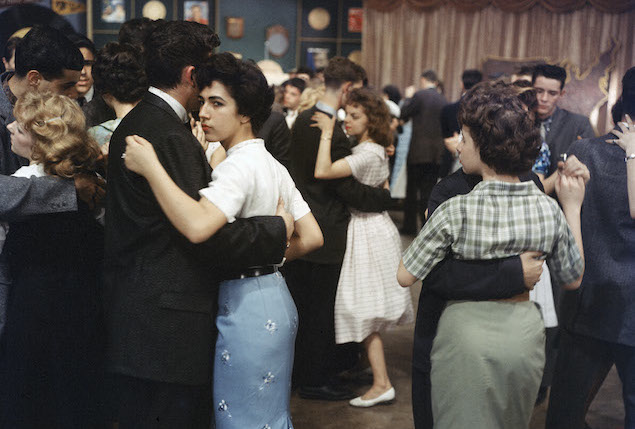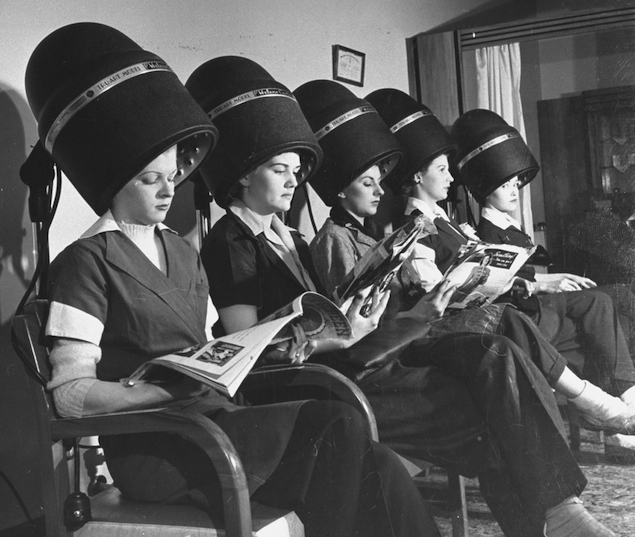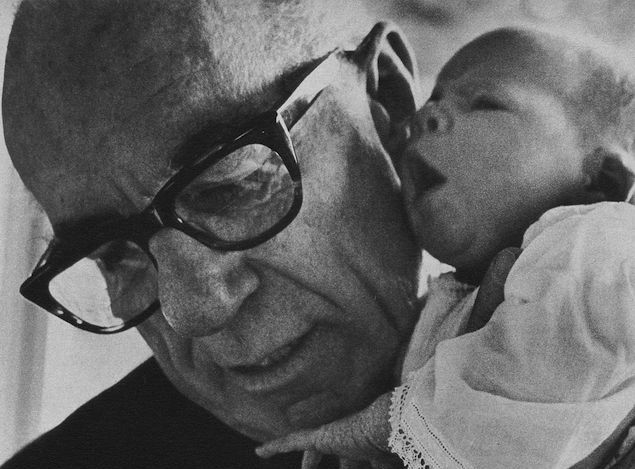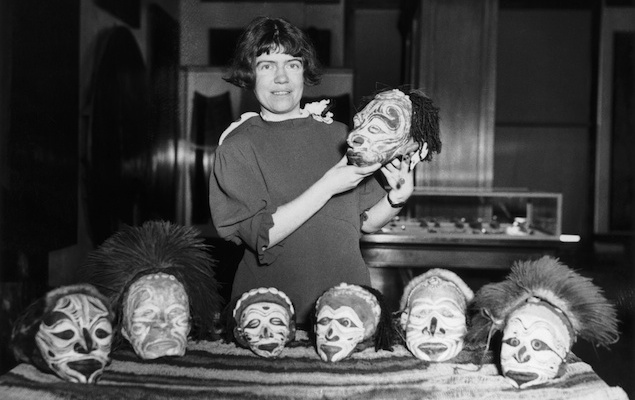Leisure • Sociology
Margaret Mead
When we use ‘modern’ to describe something, it’s usually a positive. We are very appreciative and even a little smug about the miracles of modern science, the benefits of modern technology, and even the superiority of modern viewpoints. But what if, in speeding towards a new and ever-better future, we’ve left some important truths about ourselves behind? One of the people who best helped us explore this problem was Margaret Mead, perhaps the most famous anthropologist of the 20th century.
Margaret Mead in 1942
Margaret Mead was born in 1901, the oldest of five children. Her father was a professor of finance, and her mother was a sociologist who studied Italian immigrants. When Margaret was little, her family moved frequently, and she alternated between attending traditional schools and homeschooling. She also shopped different religions (because her family members had different faiths) and eventually chose Episcopalian Christianity. Her experience sampling different beliefs and navigating new schools may have influenced her decision to study the wildly different ways people think and interact.
After studying psychology as an undergraduate at DePauw University and then Barnard College (at a time where higher education was very unusual for a woman), Mead began a PhD at Columbia University in the relatively new field of anthropology. Her supervisor, Franz Boas, was essentially the founder of the discipline in the United States. Unlike earlier anthropologists, who had imagined that civilisation was progressing in a linear fashion from ‘barbarism’ to ‘savagery’ to ‘civilisation’, Boas argued that the world was teeming with separate cultures, each with their own unique perspectives, insights, and deficiencies. The modern western world was not the pinnacle of human achievement, but simply one specific example of what humans could achieve.

View of Falefa Valley, Samoa
Boas suggested that Mead travel to Samoa, a few tiny volcanic, tropical islands in the centre of the Pacific Ocean, for her fieldwork. At the time Samoa was governed by America in the East and New Zealand in the West, and was slowly being converted to Christianity. Boas hoped the trip would allow her to study a ‘primitive’ culture that was still relatively undisrupted by the technologically developed world, and to show that it had its own insights and a highly developed culture. Much in line with Boas’s concerns, Mead was particularly interested in primitive communities because she believed that such isolated cultures could serve as ‘laboratories’ that would reveal which cultural norms were most helpful and healthy. She also believed it was critical to do this quickly; she feared that primitive cultures were slipping away, soon to be lost forever.
Starting in 1925 and lasting until the beginning of the Second World War, Mead travelled to Samoa and then to other islands in the south seas of the Pacific Ocean. She lived among native people there as an anthropologist, recording their ways of life. The groups Mead studied included many fishermen and farmers, and few literate people. Mead learned to carry babies around by having them cling to her neck and to dress in native dress. She had no access to recording devices other than still cameras, so she mostly relied on her memory and written notes—and, of course, her ability to quickly learn native languages and become popular with native people. On one island, she lived on the front porch of the Navy pharmacist’s dispensary (which had more privacy than a native house). People came to visit her at all hours of the day and night, often just to chat. She learned to be a foreigner locals didn’t mind confiding in.
Ruth Benedict in 1937
Mead’s work demonstrated a particular weakness in modern society related to sexual life. Mead herself led an unconventional life, simultaneously involved with successive husbands and her ever-present female lover—another famous anthropologist named Ruth Benedict. She believed that “one can love several people and that demonstrative affection has its place in different types of relationships.” Perhaps because Mead’s own life was neither heterosexual nor monogamous, she emphasised the ease with which other cultures allowed such practices, and the healthy relationship towards love and sex that could be maintained with these behaviours.
In her 1928 book Coming of Age in Samoa, Mead described Samoan culture as more open and comfortable with sex. The book was her first and most famous research project, for which she studied girls only a bit younger than herself: adolescents navigating their transition to adulthood. She wanted to understand whether their experiences were very different than those of American teenagers, and, if so, whether their experiences could be learned from. Most of all she wanted to test whether “societies could be changed by changing the way children were brought up.” What she found was that little children knew all about masturbation and learned about intercourse and other acts through firsthand observation, but thought of it as no more scandalous or worthy of comment than death or birth. Homosexuality was incidental but also not a matter of shame, and people’s orientations fluctuated naturally throughout their lives without defining them.

Samoan girls, c. 1902
Many of the differences Mead found were not simply curiosities, but replicable practices. Divorce was common and not shameful—a relationship was simply said to have ‘passed away’. Loving more than one person was accepted and understood to be common. Adultery might lead to divorce, but it wouldn’t have to; Mead describes how, in Samoan culture, the lover of a person’s husband or wife might gain the forgiveness of the wronged spouse:
“He goes to the house of the man he has injured, accompanied by all the men of his household…the suppliants seat themselves outside the house, fine mats spread over their heads, bent in attitude of deepest dejection and humiliation….Then towards the evening [the betrayed husband] will say at last: ‘Come, it is enough. Enter the house and drink the Kava. Eat the food which I will set before you and we will cast our trouble into the sea.’”

A Samoan family bathing c. 1950
Mead argued that because Samoan culture had an understanding of sex and all of its complexities and difficulties as part of the natural life cycle, and because their culture had developed useful, meaningful responses to address these difficulties, their personal sexual lives were much easier. For example, she found that such norms made adolescence much less difficult for Samoan girls than for American girls, because Samoan girls had relatively few responsibilities and there was little pressure for them to conform to a particular kind of sexual life. They were neither pressured to abstain from sex or to achieve particular milestones like having boyfriends or getting married. The converse of this situation meant that being an American teenager was stressful largely because of the nature of being American, rather than being teenaged.
Here Mead tapped into a deeper criticism of her own culture. She saw life for Americans of her time as one in which people are brought up “denied all firsthand knowledge of birth and love and death, harried by a society which will not let adolescents grow up at their own pace, imprisoned in the small, fragile, nuclear family from which there is no escape and in which there is little security.” Although much has changed in America and in the Western world since this time, her insights still apply in many ways. Our adolescents are still pressured to conform to particular models of human sexual behaviour, and these pressures, along with the pressures that we experience long into adulthood, make our lives more difficult and empty than they would otherwise be. Our modern life does not allow us to be as freely loving and sexual, as complex and full of change, as other cultures allow.
American teenagers at a dance c. 1950
Mead also discovered that human behaviour in relation to gender varied widely from culture to culture, far more than Americans at the time could imagine. For example, Americans thought of men as productive, sensible, and more aggressive, while women were more frivolous, peaceful, and nurturing. But in her 1935 book, Sex and Temperament in Three Primitive Societies, Mead studied tribes in Papua New Guinea and found radically different results. She recorded that in the Arapesh tribe both men and women were peaceful and nurturing, while among Mundugumor, men and women were both ruthless and aggressive. Perhaps most striking was Mead’s description of the people of the Chambri region, where the women were dominant and far more aggressive than men, while the men were dependents and in need of emotional support. In short, Mead suggested that none of these traits were ‘human nature’: they were all instead simply possibilities, which were either taught, encouraged, or shunned by native culture.
Mead’s striking conclusion was, of course, that culture determined an individual’s personality far more than people had previously expected. It was not sex that made women curl their hair or listen to people’s feelings, or ‘race’ that made some nations regularly attack their neighbours. Rather, it was the social expectations and norms that had developed slowly for centuries, and which laid the groundwork for each individual’s psychological makeup. “We must recognise,” she reminded her readers, “that beneath the superficial classifications of sex and race the same potentialities exist, recurring generation after generation, only to perish because society has no place for them.”
Group of women aviation workers sitting under hair dryers in a beauty salon, c. 1950
Modern American culture also had no place for certain potentialities—in this it was no more successful than any primitive culture. We might think, for example, that men like football because they are the more warlike sex, but in fact they have been the more warlike sex because (for some arbitrary reasons or matter of convenience) they have been the sex at war. Similarly, we may believe that women have tended to children because they are nurturing, but actually they have been guided to be nurturing because they were assigned the task of raising children. In making these assumptions, we forget about human potential for gentleness and roughness that other cultures have forgotten.
In making this criticism, Mead followed in a long line of thinkers who recognised that modern civilisation, with all of its technological advantages and rapid developments, had left some aspects of human experience behind—either unrecognised, misunderstood, or poorly tended to. In this sense, she was much like the Genevan philosopher Jean-Jacques Rousseau (1712-1778) who had described human beings as originally having a very different, and far more solitary nature. Rousseau suggested that as civilisation developed, human nature was moulded by society—often for the worse; this artificial construction of social order (often through violence and oppression), he argued, limits human potential.
Mead’s point, in turn, was that even now we wrongly assume the conventions that Rousseau describes as unnatural, and in doing so we miss out on greater possibilities, both for how to behave as individuals and how to reorganise societies. She believed that by studying other cultures, especially primitive ones that had developed apart from our own, we could better explore these possibilities. Perhaps, for example, we can choose when to be loving and when to be aggressive, when to demand a certain standard of sexual behaviour and when to learn how to gracefully and conscientiously accommodate our differing needs.
American women doing men’s work in the arsenals of war in the US, c. 1940
Mead strongly believed that it was important to consider cultural norms because people needed their culture to help guide them towards healthier emotional lives. She imagined that each culture, like a tribe cast out from the Tower of Babel and given a unique language, had something unique to contribute culturally as well: “Each primitive people has selected one set of human gifts, one set of human values, and fashioned for themselves an art, a social organisation, which is their unique contribution to the history of the human spirit.” The beauty of these differences was not that the people she studied always had it better figured out than Americans (sometimes she could be very critical of the people she studied), but rather that both groups could learn from each other: “from this contrast we may be able to turn, made newly and vividly self-conscious and self-critical, to judge anew and perhaps fashion differently the education we give our children.”
Indeed, Mead herself had learned much from her anthropological subjects. For example, she brought up her daughter, Mary Catherine Bateson, on some of the parenting of the primitive people she worked with. Mead enlisted a new physician, Dr. Benjamin Spock, as the child’s doctor, in part because he allowed unconventional practices like breast feeding on demand, which Mead had learned from her research subjects (and which is now commonplace in western culture, thanks in part to Dr. Spock).
Benjamin Spock with his niece Susannah in 1967
During World War II access to the South Pacific was impossible, so Mead began to study more ‘complex’ cultures like her own. She was also asked to turn her research to war purposes, first by studying how to maintain morale during wartime, and then by studying the social complexities of food distribution. She even wrote a book on American national character entitled And Keep Your Powder Dry (1942). With the help of her husband Gregory Bateson, she founded the Institute for Intercultural Studies in order to establish further study of other cultures.
After the war, Mead also worked for the US Military, studying Russian responses to authority in order to try to predict what the Soviets might do during the cold war. She grew increasingly famous, travelling widely, giving lectures, and teaching at universities. For 50 years, from 1928 until her death in 1978, she worked for the American Museum of Natural History in New York City as a curator for their projects. She wrote 20 books, was made a fellow of the American Academy of Arts and Sciences, was awarded 28 honorary degrees, and was posthumously awarded the Presidential Medal of Freedom.
Mead studying Tzantzas brought back from a trip to New Guinea, 1934
Mead was a supporter of many political causes, fighting against poverty and racism and supporting women’s rights. She wrote a book showing how many of the differences in intelligence between ‘races’ that psychologists had measured were instead the result of cultural knowledge and convention. She encouraged her readers and listeners to also think of social problems as culturally conditioned, issues that could be overcome by new efforts and ideas. She is famous for having (probably) said, “never doubt that a small group of committed people can change the world. Indeed, it is the only thing that ever has.”
Mead’s own committed work helped generations of Americans and people everywhere see greater possibilities for individuals and for modern values. She suggested that we see human nature less as a singular and universal fact and more as an ever-changing landscape, one through which we should travel in order to become wiser. “As the traveller who has once been from home is wiser than he who has never left his own doorstep,” she suggested, “so a knowledge of one other culture should sharpen our ability to scrutinise more steadily, to appreciate more lovingly, our own.” In doing so, she suggested, we could uncover and support undeveloped human potential forgotten in our rush towards ‘modernity’.
































